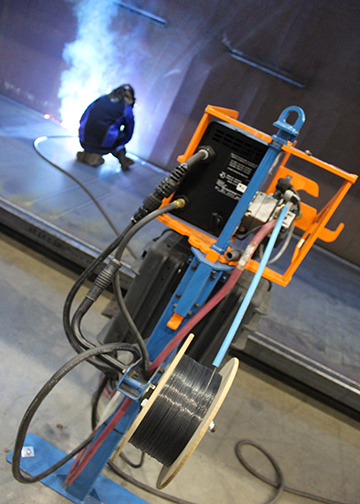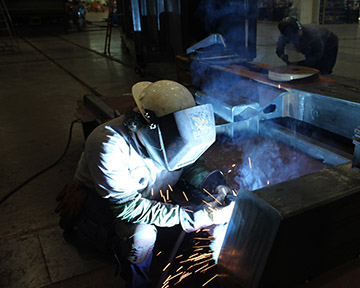Is Metal-Cored Wire the Right Choice?
In today’s competitive environment, companies are always looking for ways to improve productivity and gain an edge, while still keeping costs low and producing high-quality parts. There are a number of solutions that can help companies reach these goals — from investing in more efficient equipment or welding processes, to improving workflow and implementing a more effective parts inventory.

wire eliminates certain pre- and post-weld
activities (often referred to as non-value-
added activities).
Whatever the solution being considered, labor is always part of the conversation. Labor costs on average make up more than 80 percent of the cost of semi-automatic welding. The ability to reduce or eliminate the time spent on certain tasks during the welding process — such as cleaning, applying anti-spatter, removing spatter and slag, and post-weld grinding — can provide significant productivity and efficiency benefits without adversely impacting the overall throughput or quality of the welding operation.
In the right applications, metal-cored wire is among the solutions that can provide productivity and time-saving benefits. There are some key steps that can help determine if metal-cored wire is the right choice.
Behind the technology
As with any type of filler metal, metal-cored wire has its own specific characteristics, benefits, limitations and best-suited applications. Because metal-cored wire is a hollow metal sheath filled with metallic powders, alloys and arc stabilizers, these special formulations can create distinct results. These include lowering oxidation, providing higher impact strengths and reducing silicon depositions in the final weld. These characteristics also make metal-cored wire especially suitable for welding through mill scale — and fine oxide layer found on hot-rolled steels — and other contaminants.
When welding with metal-cored wire, the spray transfer process is used. This process creates tiny filler metal droplets that deposit in the weld puddle and generate little to no spatter. Because the current travels through the outside metal sheath, the wire produces a broad, cone-shaped arc. This results in a wider penetration profile as compared to the more finger-like penetration of solid wire. This arc shape also creates a wide, consistent bead profile that bridges gaps easily and accurately without burn-through.
The construction of metal-cored wire also allows for greater travel speeds and deposition rates, and helps minimize porosity and undercut in the final weld. All of these factors can increase productivity and allow welding operators to weld more efficiently, deposit more weld metal, reduce quality issues and spend less time cleaning the weld.
Metal-cored wire is suitable for flat, horizontal, vertical down and overhead welding using a standard constant voltage power source. Vertical up welding is also possible with a power source that provides pulsing capabilities, though it will generally be slower using metal-cored wire compared to flux-cored wire. Metal-cored wire is capable of single or multi-pass welding, and requires high argon shielding gas mixtures (a minimum of 75 percent).
Industries such as heavy equipment manufacturing, rail car fabrication, automotive exhaust, chassis and wheel manufacturing, and food and petrochemical fabrication all have welding applications in which metal-cored wire excels. This is due partly to the fact that the wires can be alloyed for most types of steel, from mild and stainless to low alloy. Many of these industries also frequently weld 1/4-inch and thicker material, another application where metal-cored wire offers solid productivity solutions, specifically due to its gap-bridging capabilities.
One consideration to keep in mind is that metal-cored wire, on average, costs more per pound than other types of filler metals. However, it can yield productivity increases that offset the initial cost.
What are the benefits?
While metal-cored wire typically has faster travel speeds and higher deposition rates than other types of wire (especially solid wire), the technology can offer its greatest productivity benefits in the pre- and post-weld phases. In some welding operations, using metal-cored wire eliminates certain pre- and post-weld activities (often referred to as non-value-added activities). This allows the time spent on those tasks to be allocated elsewhere, in ways that can improve the overall productivity of the operation.
Activities such as grinding, sand blasting or applying anti-spatter are typical in many welding operations and it is common to find designated pre-weld areas where these occur. Some companies also have post-weld areas where additional grinding or necessary rework happen. Both of these areas are often considered part of the overall production process, but they can cause bottlenecks in the welding operation that adversely affect throughput of the fabricated part. Additionally, the labor allocated to these areas costs money.
Since metal-cored wire tends to create little to no spatter and minimizes defects such as undercuttingor lack of fusion, post-weld activities such as grinding or chipping spatter usually aren’t necessary, which saves labor time and money. Additionally, reducing the necessary post-weld activity helps increase the flow of completed parts to other stages of production, such as painting or coating, to improve overall productivity.

operation’s productivity, the first step is assessment of the pre-
and post-weld areas in the welding operation to establish
whether there is a solid baseline for improvement.
Is it the right solution?
To determine whether metal-cored wire can increase an operation’s productivity, the first step is assessment of the pre- and post-weld areas in the welding operation to establish whether there is a solid baseline for improvement. An assessment considers all activities and associated labor occurring in the pre- and post-weld areas, along with the impact on overall workflow. A trusted welding distributor or filler metal supplier can often help with this task.
Consider pre-weld activities: Are activities such as grinding, sandblasting or applying anti-spatter absolutely necessary, or are they compensating for the welding wire being used? It’s also important to determine whether these activities are causing bottlenecks or slowdowns in the upstream portion of the welding operation.
Quantify time: How much time and labor is spent on these activities? Also factor in the cost and time for maintaining and repairing grinding or sandblasting equipment, and consider the time and cost of any possible issues of operator fatigue or repetitive injuries.
Consider post-weld activities: Quantify the overhead for activities that occur in the post-weld area of the operation, such as grinding or scraping spatter. Include the labor and equipment costs, along with the time it takes to complete each activity per part. If there are issues with undercut, lack of fusion or other weld discontinuities that require part rework, quantify that time and labor as well. Most importantly, calculate any material and labor cost for rejected parts that must be scrapped due to irreparable quality issues.
Look at the weld cell: During the assessment, also consider the activities that occur in the actual weld cell, such as the volume of parts welded per shift, the arc-on time and the welding parameters. While there are fewer opportunities for productivity increases here, it’s still important information that can help when calculating the potential impact of switching to metal-cored wire.
Establish a baseline: Once all information on the pre- and post-weld areas of a welding operation is gathered and welding cell data has been quantified, a baseline for improvement can be established. This baseline helps determine if a welding operation is a good candidate for metal-cored wire. Consider if pre- and post-weld activity volume is higher than desired; if labor costs in those areas are high; if quality issues result in a high volume of rework; and if productivity is lower than desired.
Determining the payback
Because metal-cored wire often costs more than other filler metals, it’s important to be able to justify to upper management, the purchasing department or owners that the additional investment or process change will offer payback through improved productivity and efficiency.
First, show how the data collected during the pre-weld assessment of the welding operation can translate into a better use of labor — or more importantly, labor that adds to greater productivity. For example, if an operation contains a significant amount of pre-weld activities, show how metal-cored wire could reduce labor by eliminating sandblasting, anti-spatter application or grinding, and then calculate the potential time and cost savings. Also, show how much of that labor could be reallocated elsewhere in the welding operation, particularly to the weld cell, to produce a higher volume of parts. Likewise, consider how much labor could be moved from the post-weld area of the welding operation to the welding cell if the volume of rework or parts rejection could be reduced with metal-cored wire.
Lastly, if there are possible improvements that could occur in the weld cell by converting to metal-cored wire. The higher deposition rates and faster travel speeds of metal-cored wire offer the possibility of completing the welding process faster, to increase overall productivity.
Remember, as when considering any potential change in the welding operation, determining whether metal-cored wire is the best choice will take time. Don’t rush the assessment or decision, and be sure to trial the wire in a limited capacity — even one weld cell — to begin. Doing so can help ensure that the application is well-suited for a conversion and that it will ultimately be successful.



